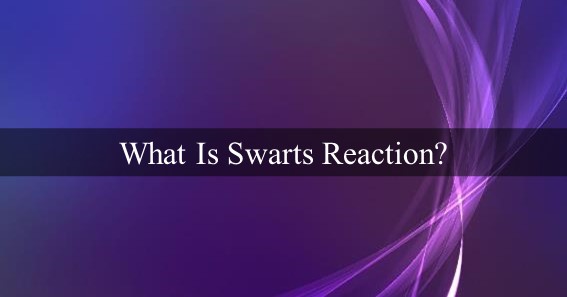Are you curious to know what is swarts reaction? You have come to the right place as I am going to tell you everything about swarts reaction in a very simple explanation. Without further discussion let’s begin to know what is swarts reaction?
Chemistry is a realm of intricate reactions and transformations that drive scientific progress and innovation. Among the myriad reactions that have contributed to our understanding of chemical processes, the Swarts Reaction stands out as a notable example. Named after the Swiss chemist Fredrick Swarts, this reaction has paved the way for the synthesis of diverse compounds with a range of applications. In this blog, we will delve into the Swarts Reaction, its mechanism, and its significance in the world of chemistry.
What Is Swarts Reaction?
The Swarts Reaction is a chemical reaction that involves the substitution of a halogen atom in an organic compound with a fluorine atom. It is a notable method for introducing fluorine into organic molecules, resulting in the formation of fluorinated compounds. Fluorine is a unique and highly reactive element, making its incorporation into organic molecules a valuable tool for drug discovery, materials science, and various other fields.
Key Components And Mechanism
The Swarts Reaction typically involves the use of a halogen (chlorine, bromine, or iodine) compound and a fluorine source (usually hydrogen fluoride or a metal fluoride). The reaction is catalyzed by Lewis acids, such as antimony pentafluoride (SbF5) or silver fluoride (AgF), which facilitate the exchange of halogen and fluorine atoms.
The general mechanism of the Swarts Reaction can be summarized as follows:
- Activation: The Lewis acid catalyst activates the halogen molecule, making it more susceptible to nucleophilic attack.
- Nucleophilic Substitution: The activated halogen molecule undergoes nucleophilic substitution, where the halogen atom is replaced by a fluorine atom from the fluorine source.
- Formation of Fluorinated Compound: The result of the reaction is a fluorinated organic compound, where the halogen has been replaced by a fluorine atom.
Significance And Applications
The Swarts Reaction holds significant importance in various scientific and industrial contexts:
- Medicinal Chemistry: Fluorinated compounds synthesized through the Swarts Reaction are widely used in pharmaceutical research, as fluorine substitution can influence the bioactivity, stability, and pharmacokinetics of drugs.
- Materials Science: The introduction of fluorine atoms can modify the properties of materials, leading to improvements in areas such as polymer coatings, electronic components, and superhydrophobic surfaces.
- Agricultural Chemicals: The Swarts Reaction contributes to the synthesis of agrochemicals, where fluorinated compounds can enhance the efficacy and selectivity of pesticides and herbicides.
- Fluorinated Building Blocks: Fluorinated organic compounds obtained through the Swarts Reaction serve as valuable building blocks for more complex molecular structures.
- Diagnostic Imaging: Fluorinated compounds are used in positron emission tomography (PET) imaging, enabling the visualization of specific physiological processes in the human body.
Conclusion
The Swarts Reaction stands as a testament to the power of chemical reactions in shaping scientific discovery and technological advancement. By enabling the controlled introduction of fluorine atoms into organic molecules, this reaction has opened up new possibilities in drug development, materials science, and various other fields. As researchers continue to explore the potential of the Swarts Reaction, its impact on our understanding of chemistry and its practical applications will continue to unfold, driving progress and innovation in diverse areas of science and industry.
FAQ
What Is The Swarts Reaction In Simple Terms?
The Swarts reaction mechanism is quite simple – the metal fluorine bond is broken and a new bond is formed between carbon and fluorine. The displaced chlorine or bromine atoms now bond with the metal. The mixture of antimony trifluoride and chlorine is referred to as Swarts reagent.
What Is Swartz Reaction With An Example?
Example of swarts reaction or shwartzman reaction:-
(SbF3 + Cl2) and heavy metals fluorides such as AgF, F2Hg2, CoF2 or SbF3. In general if we have to prepare metal fluorides we use swarts reaction or swarts fluorination reaction.
What Is The Swarts Reaction Also Known As?
In 1892, Frederic Jean Edmond Swarts was the first to report this phenomenon. The swarts reaction is also known as swarts fluorination. Chlorine is most commonly replaced by fluorine in organic compounds via Swarts fluorination in the presence of antimony salts, where its oxidation state is +5.
Is The Swarts Reaction Sn1 Or Sn2?
Swarts reaction involves the breakdown of metal and fluorine bond and the formation of bond between carbon and fluorine. Thus, one halogen atom is replaced by another. Due to this reason, Swarts reaction is an SN2 reaction.
I Have Covered All The Following Queries And Topics In The Above Article
What Is Swarts Reaction
What Is Swarts Reaction Class 12
What Is Swarts Reaction With Example
What Is Swarts Reaction Give Example
What Is Swarts Reaction Explain With Example
What Is Swarts Reaction Explain With An Example
What Is Finkelstein And Swarts Reaction
What Is Swarts Reaction?
What Is The Reagent Used In Swarts Reaction
What Is Swarts Reaction
